Over the past year, Iran has been rapidly advancing towards becoming a hyper-surveillance state. The government has implemented various policies and systems designed for extensive monitoring and control of its citizens. This includes attempts to develop facial recognition systems, e-governance services, localized internet infrastructure, and integrate user data across different sectors. These efforts have been undertaken without any legal framework to protect citizens’ data, leaving the door open to widespread surveillance and serious privacy violations.
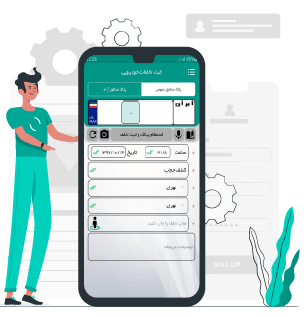
The Nazer app represents a new dimension of the growing state surveillance system. Developed by the Naji Research and Development Company (NRDC) for Iran’s Law Enforcement Forces (NAJA), Nazer is a reporting tool aimed at allowing police and specially designated private citizens to report women to law enforcement for not complying with Iran’s compulsory hijab rules. The latest version of Nazer has expanded to allow reporting on a range of behaviors deemed immoral, such as eating during Ramadan, as well as undefined notions of “behavior against public morality.” Moreover, the new Nazer seeks to identify protest participants and suppress freedom of peaceful assembly.
In effect, Nazer is a powerful surveillance tool with extensive capabilities for monitoring and controlling citizens, particularly targeting women in Iran. It seeks to punish a wide range of personal behaviors, as well as expressions of civil political dissent, thereby violating internationally protected rights of people in Iran.
The Nazer application, unavailable on public app stores, is distributed through specific channels such as the police website and Iranian messaging platforms like Eitaa. This restricted distribution highlights its targeted use. Nazer operates its Application Programming Interface (API) primarily through the National Information Network (NIN), meaning that it functions on Iran’s state-controlled internet. This setup enables the government to isolate the app’s usage and closely monitor its impact on the population.
Beyond Hijab to Wide-Ranging Public Behavior
Initially, the Nazer app was designed to allow government officials and approved volunteers to report individuals violating compulsory hijab rules while in vehicles. The user would simply select options in the app outlining the type of violation, location, date, time, and enter a license plate number. The app could automatically send warnings and citations through SMS messaging, but law enforcement could also charge individuals with various offenses under Iranian law, subjecting them to criminal trials and punishments, including fines, imprisonment, and lashings.

Filterwatch’s most recent analysis reveals that the app’s monitoring capabilities have expanded significantly. It now includes a range of so-called morality offenses, including alcohol consumption, eating during Ramadan, cruising in cars, and the vague “behavior against public morality.”
Over the past year, the enforcement of hijab-related laws in Iran has led to the seizure of a significant number of vehicles. According to various reports, thousands of cars have been impounded due to violations of hijab laws inside vehicles. In June 2024 alone, over 8,000 cars were released from impound as part of amnesty programs, but many others continue to be seized as part of ongoing enforcement efforts.
The process typically begins with a warning message sent to the car owner after the first violation. If the offense is repeated, the vehicle is subjected to either electronic suspension, on-site immobilization, or full impoundment in a police lot. The costs of releasing impounded vehicles vary depending on several factors, including the parking location and tow truck fees. According to published reports, these costs can potentially impose over several thousand dollars (tens of millions of ُomans) on vehicle owners
Offenses found on updated version of the Nazer app include:
- Removal of the Hijab (کشف حجاب)
- Improper Hijab (بد حجابی)
- Riots or Unrest (اغتشاشات)
- Harassment of Women’s Dignity (مزاحمت نوامیس)
- Drinking Alcohol and Drunk Driving (شرب خمر و رانندگی در مستی)
- Noise Pollution (آلودگی صوتی)
- Eating During Ramadan (روزه خواری)
- Loitering or Cruising Around (دور دور و پرسه زنی)
- Behavior Against Public Morality (رفتار خلاف عفت عمومی)
Additionally, while earlier versions of the app focused on hijab violations in cars, the latest version can now track offenses across various vehicle types. Most alarming is that ambulances are among the vehicle options, suggesting that enforcing hijab rules is a priority for Iranian authorities, even in situations involving medical emergencies.
Vehicles found on updated version of the Nazer app include:
- Car or Sedan (سواری)
- Truck (وانت)
- Taxi (تاکسی)
- Heavy Truck (کامیون)
- Small/Light Truck (کامیونت)
- Trailer Truck (کامیون کشنده)
- Minibus (مینی بوس)
- Agricultural Vehicles (کشاورزی)
- Bus (اتوبوس)
- Ambulance (آمبولانس)
- Trailer (یدک)
The Nazer update also provides a long list of all vehicle brands found in Iran. These categories illustrate the app’s capacity to target a wide range of behaviors and vehicle types. The app also distinguishes between various regions in Iran, such as free-trade zones, although the legal ramifications of these regional distinctions remain unclear.
The new version of the app also provides a direct contact phone number for users to reach the app’s support line, facilitating immediate communication between users and the authorities managing the app.

Arbitrary Enforcement and Broader Implications
Because there is no clear legal definition of what constitutes improper hijab under Iranian law, enforcement is inconsistent and can vary widely based on the individual views of law enforcement and judicial officers. This ambiguity allows for a broad range of personal actions to be classified as violations, creating a climate where personal freedoms are frequently curtailed. Moreover, the vagueness in the law leads to targeted, arbitrary, and discriminatory harassment of women, as there is no equivalent moral code for men. While men are occasionally targeted for immoral dress and appearance in Iran, it is a far less common occurrence.
On September 25, 2024, a new anti-hijab law, “Hijab and Chastity,” discussed below, received final approval from the Iran Guardian Council. In some cases, it can impose harsher penalties and, in others, lighter penalties.
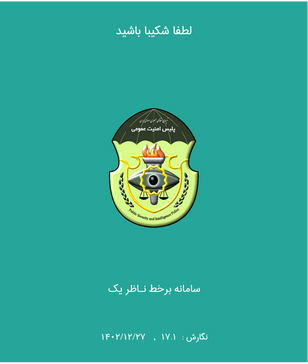
Nazer One Online System
Version 171
March 17 2024
The Nazer app distinguishes between various regions in Iran, such as free-trade zones, although the legal ramifications of these regional distinctions remain unclear.
Nazer’s inclusion of “behavior against public morality” appears to reference an offense of the same name under Part 1 of Article 640 of Book 5 of the Islamic Penal Code of Iran. This crime is loosely defined as offenses against widely accepted moral norms. According to Iranian legal expert and human rights lawyer Hossien Reassi, who spoke with Filterwatch on December 24, 2024, the vague and overbroad nature of the offense, in both theory and practice, allows arbitrary enforcement of an undefined number of acts that law enforcement or judges subjectively deem improper.
As such the offense has been used to punish various forms of dress deemed improper beyond hijab or public displays of romantic affections for unmarried couples. The law can additionally be used to target same-sex romantic behavior or non-conforming gender expression leaving the door open to Nazer targeting LGBTQ+ individuals. Under article 640 the punishment for “behavior against public morality” included imprisonment from three months to one year, up to 74 lashes, or fines of From 2,000,000 to 10,000,000 Rials (approximately 47 to 238 USD).
The terms “riots” or “unrest” are often used by Iranian authorities to describe public protests and demonstrations. In this context, the Nazer app categorizes such activities as criminal offenses, thereby criminalizing peaceful protest actions and dissenting voices. This reflects the state’s policy of viewing protests as disruptions to public order rather than legitimate legally protected expressions of discontent. Iranian authorities have a long documented pattern of suppressing peaceful protests and punishing participants and organizers with prison sentences and lashings. Indeed, authorities already use other methods to identify and arrest protesters after protests. Nazer will effectively increase the capacity of law enforcement and pro-government volunteers to restrict freedom of assembly and punish individuals for exercising that right.
Additionally, the app can identify the exact location of passengers within a vehicle, categorizing them into three roles: driver, front passenger, and rear passenger, enabling more detailed offense reporting and potential criminal targeting of specific individuals.
Our investigation reveals that the app operates within a broader, complex infrastructure that can significantly impact those identified as offenders. For instance, users whose vehicles are reported receive warning SMS messages:
- The first message allows the user to appeal, but research by Filterwatch shows that these appeals are often ignored.
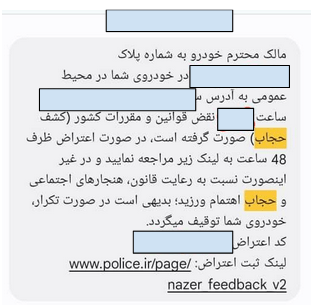
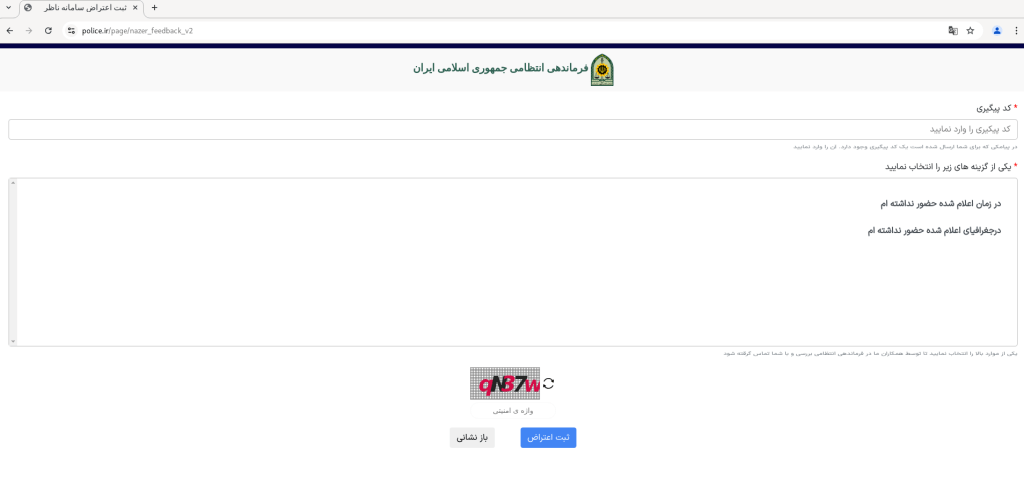
- The second message imposes a 15-day suspension on vehicle-related services, including prohibiting the sale or receipt of services. Users are directed to designated parking locations for impounded vehicles.
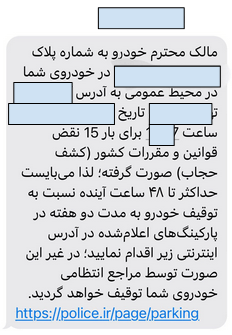
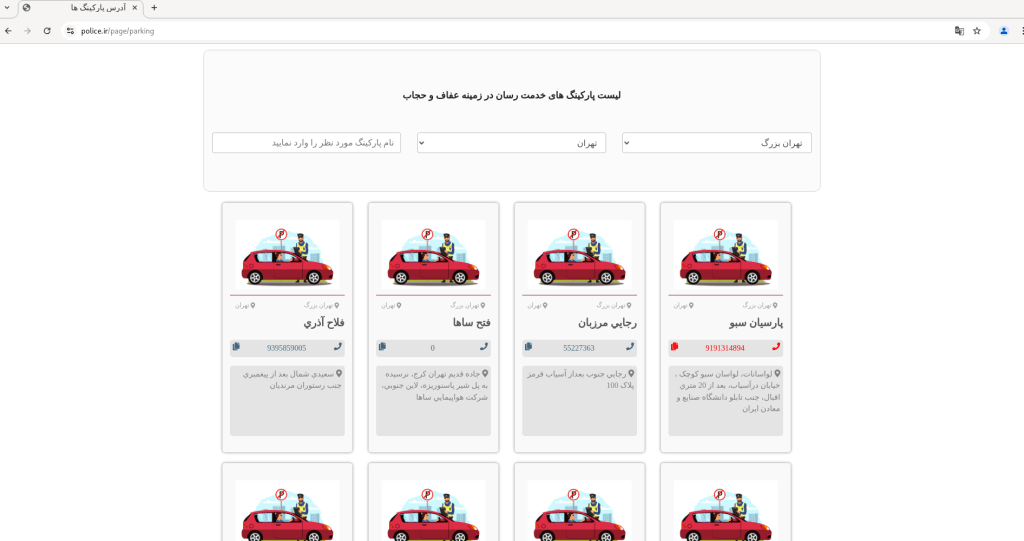
- The third message results in the vehicle being impounded.
Law: Hijab and Chastity Bill
The Iranian Parliament’s Hijab and Chastity law is closely aligned with the Nazer app’s functionality, particularly regarding the monitoring of individuals in vehicles for violations of hijab laws.

- Article 47: Anyone who wears inappropriate attire in public spaces, public places, or streets will, on the first offense, be fined up to the maximum of grade six penalties. For repeat offenses, the offender will be fined at grade five. If the offense is repeated more than four times, the offender will face the repeat offense penalties outlined in Article 37 of this law.
Clause 1: Inappropriate attire for women is defined as wearing transparent or tight clothing, or clothing that reveals any part of the body below the neck, above the wrists, or above the ankles.
Clause 2: Inappropriate attire for men is defined as wearing transparent clothing, or clothing that reveals any part of the body below the chest, above the shins, or the shoulders.
- Article 48: Any person who appears naked or semi-naked in public spaces, public places, or streets, or wears attire that is socially considered as nudity, will be immediately detained by law enforcement officers and referred to the competent court. They will be sentenced to fourth-degree imprisonment or a third-degree fine, and in case of repeated offenses, the penalty of imprisonment or fine will be increased by one degree. The law enforcement officers mentioned in this article include all officers of the Law Enforcement Command of the Islamic Republic of Iran (FARAJA) and general or special judicial officers.
- Article 49: Any woman who appears in public spaces, public places, or streets without a headscarf (such as a chador, headscarf, or shawl) covering her head, will be fined at the maximum of a sixth-degree penalty for the first offense. For subsequent offenses, she will be fined at a fifth-degree penalty. If repeated more than four times, the offender will face the repeat offense penalties outlined in Article 37 of this law, excluding imprisonment.
Clause: Men entering spaces reserved for women in public places or transportation are subject to the penalties of this article.
- Article 50: Committing any of the offenses mentioned in Articles 47, 48, and 49 of this law during public ceremonies or gatherings results in an increase of the prescribed penalties by one degree.
- Article 51: If there is strong suspicion that the person committing any of the offenses under this law is a non-Iranian, law enforcement officers must first verify their identity. If it is determined that the individual is not Iranian, their passport or residence permit will be confiscated, and after the prescribed penalties under this law are applied, they will also be sentenced to the penalties outlined in Clause “Kh” of Article 23 of the Islamic Penal Code at the judge’s discretion.
- Article 52: Motor vehicles where the driver, rider, or passengers commit acts of indecency, unveil, wear improper attire, or violate hijab regulations will be fined five million rials by the officers of the Law Enforcement Command of the Islamic Republic of Iran (FARAJA). Additionally, imposing fines on the vehicle does not prevent applying the prescribed penalties to the offender(s). This rule also applies to taxis and online ride-hailing services. The recording of the first offense will prevent the recording of subsequent offenses in terms of timing, and monetary fines will accumulate.
Clause 1: If a motorcyclist or passenger commits nudity, semi-nudity, improper attire, or unveils, the motorcycle will be immediately impounded for one week by law enforcement officers, and the owner will be fined twenty million rials by the judiciary. This does not prevent the imposition of penalties outlined in Articles 47, 48, and 49.
Clause 2: Online ride-hailing platforms must, within two months, set up systems that allow drivers to report passengers who violate this law. If a driver submits a report regarding a passenger violating this law, they will be exempt from paying the fine. These platforms must also establish online communication channels with law enforcement officers (FARAJA). Failure to comply will result in the platform being fined an amount equivalent to three months’ profits from its revenue.
Clause 3: If the motor vehicle involved in these offenses has no license plate, or its plate is tampered with, illegible, or covered, the vehicle will be impounded for twice the usual duration, and the fines mentioned in this article will be doubled.
- Article 52: states that drivers or passengers who commit offenses such as “unveiling” or “improper hijab” will be fined. The app’s surveillance capabilities allow it to monitor and report these offenses in real time, aligning with this law. It automates much of the enforcement process, enabling authorities to track repeated offenses efficiently.
Clause 1: specifically targets motorcyclists for unveiling or immodesty, allowing for immediate impoundment and fines. The Nazer app’s enhanced surveillance capabilities assist authorities in identifying offenders quickly.
Clause 2: mandates ride-hailing platforms to implement reporting mechanisms for drivers to report passengers violating the law. The app can integrate with these platforms, facilitating direct communication between drivers, authorities, and the app.
Clause 3: addresses vehicles without plates or with obscured plates, stating harsher penalties. The app’s monitoring system aids in identifying vehicles trying to evade detection.
Clause 4: allows citizens to contest fines, with the Nazer app potentially providing digital evidence to support or challenge appeals.
The Nazer app essentially becomes a tool for enforcing these laws, systematically identifying violations, facilitating penalties, and involving various stakeholders, including law enforcement, volunteer law enforcement, and ride-hailing services, in the surveillance network.
The Application’s Technical Details
The Nazer app requires detailed user registration, including phone numbers and IMEI, to ensure that only pre-approved individuals can use the app. This ensures tight control over the app’s users and prevents unauthorized access.

The app’s extensive permissions grant deep access to the device, including reading phone state, intercepting SMS, tracking location, and modifying secure system settings. These permissions allow the app to control functions such as intercepting messages and tracking user movements. Given that the app is not only to be used by police and formal security forces but also law enforcement volunteers, who are by definition private citizens, these permissions raise deep privacy concerns for users as well.
Technically, Nazer includes several functions such as DiagramActivity, QuestionAnswerActivity, and HistoryActivity, which allow it to record and analyze its user data. It uses SmsReceiver to intercept SMS messages, likely to verify authentication codes. The app communicates with police servers via updated API endpoints, facilitating real-time data exchange.
Security features include root detection which is the highest level of administrative control over a device, typically allowing unrestricted access to system files and settings. If root access is detected, the app deletes sensitive data and shuts down such as the history of text messages.
For non-rooted devices, the app functions normally while securing data through encryption. The app can also install updates automatically via SMS, ensuring it remains up to date.
Technical Information
File name: nazer_vc38_vn17.1.apk
MD5: 3f4a531846d34399f7c61f0ca4f5bd03
SHA256: 6913dce5198d5bc860e4eb517415715319cddbba7b8241661e8205e7790fd179
API Call: https://nazer1.police.ir/api/
Who Is Behind Nazer
Nazer was developed for Iranian security forces by Naji Research and Development Company (NRDC).The company claims that its mission is to leverage IT expertise in Iran to advance electronic governance. In January 2023, NRDC was officially recognized as a government-approved knowledge-based company.
According to the “About Us” section on the company’s website, NRDC is affiliated with the The Cooperative Foundation of the Law Enforcement Command of the Islamic Republic of Iran (NAJA) also known as the NAJA Cooperative Foundation. NAJA, and several of its officers , was sanctioned by the U.S. Department of the Treasury’s Office of Foreign Assets Control (OFAC) in October 2019.
In November 2022, the hacker group Anonymous disclosed leaked emails from Iran’s Working Group for Determining Instances of Criminal Content. These emails showed that Afsaneh Valaee, using the email address valaee[at]eadl.ir (Eadl.ir belongs to the Electronic Judicial Data Processing Organization in Iran which is part of Judiciary of the Islamic Republic of Iran), had contacted Mehdi Amiri, an official in the Iranian Prosecutor’s Office, on March 3, 2021. In her email, Valaee outlined the NRDC’s forensic services and proposed organizing a forensic training course for the office. This exchange shows that NRDC has collaborated closely with the Prosecutor’s Office and plays a significant role in developing IT services for Iran’s judicial and security sectors.
Despite the absence of forensic services on the company’s updated website, earlier versions mentioned digital forensic and cybersecurity services as part of NRDC’s offerings.
